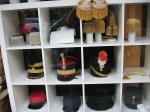The maker of our china pattern, Petrus Regout, was just a name on the back of a plate until we went to Maastricht. There in the archives (built inside a bombed out church — very beautiful) we learned more.
Regout was born in Maastricht in 1801 and died in a suburb of the city in 1878. His family had a shop in Catholic Maastricht selling English earthenware and glass and French crystal. Petrus began working in his parents’ store when he was 13 years old. Later he opened his own shop in the nearby Belgian city of Liege.
In 1830 the [Catholic] Rebellion of Belgium against the rule of [Protestant] William of Orange interfered with trade in the Maastricht area. The river Maas was closed to all traffic, making shipping impossible. And the Dutch stopped buying from Maastricht anyway, considering it part of Belgium. To make matters worse, Regout had been importing unpainted pottery from Belgium and finishing it in Maastricht. The war meant no more imports. It would have put a lesser man out of business.
Regout, however, had married well. His wife, Maria Aldegonda Hoeberechts, was from a wealthy family of hatmakers. Her subsantial dowry was soon invested in the company. Regout bought a steam engine, and commenced manufacturing his own products, using English earthenware as his inspiration and copying many patterns. The English, of course, were using China as their inspiration, and copying many Chinese patterns. Hence the Dutch production of patterns heavily influenced by the Far East.
And Regout wasn’t just making pottery. He was also selling into the healthy war market. In addition to the pottery factory, he had a nail factory, a glassworks, a gun factory and a gas works by 1847, and is generally acknowledged as the father of industrial revolution in Holland. He became a Member of the Dutch senate, and his son Louis later became Prime Minster.
Regout and his wife had ten children, including five sons, who all went into the family business. The factory was one of the largest producers of pottery in the world, but after World War II, the company turned from tableware to the production of bathroom fixtures. Nearly every toilet in Holland now bears The Mark of the Sphinx!
Looking on a map for the former site of Regout’s reportedly lavish summer house, we spotted the town of Beek. Wasn’t that where old Mr. Vanderdonck was born? Yes! And on the way was Rekem, the former Reckheim, which appeared in one of the ancestral documents.
So we scrapped our plans to visit Liege and Aachen, and set out again on the genealogy trail.
Next: what we found in Rekem.



